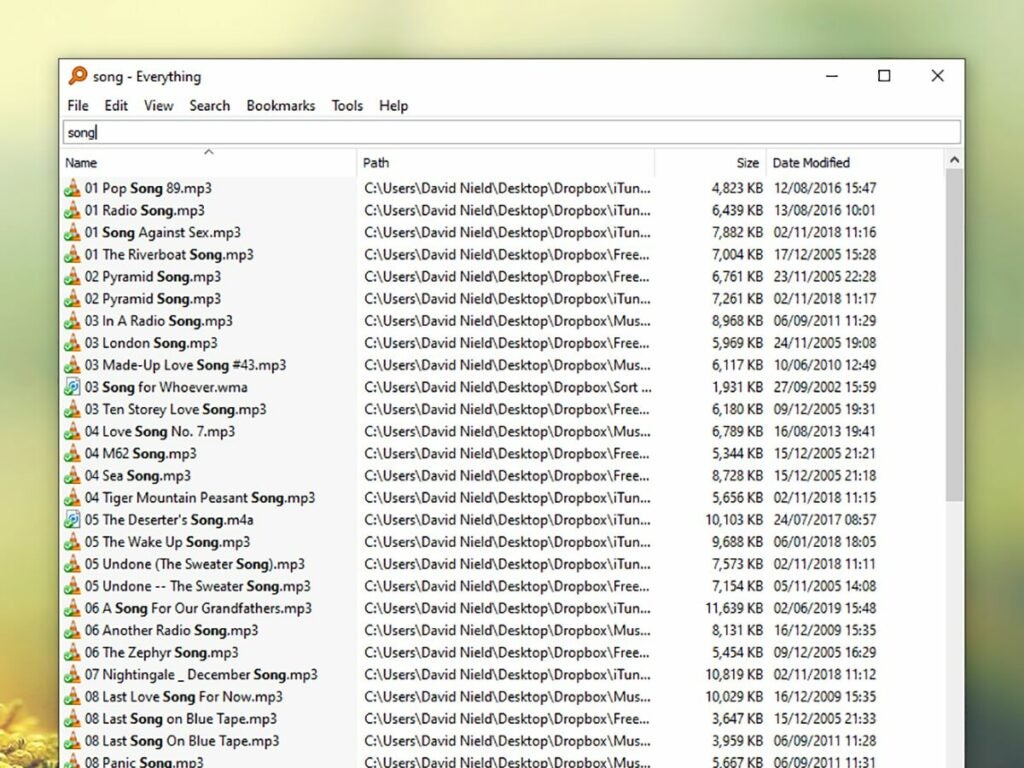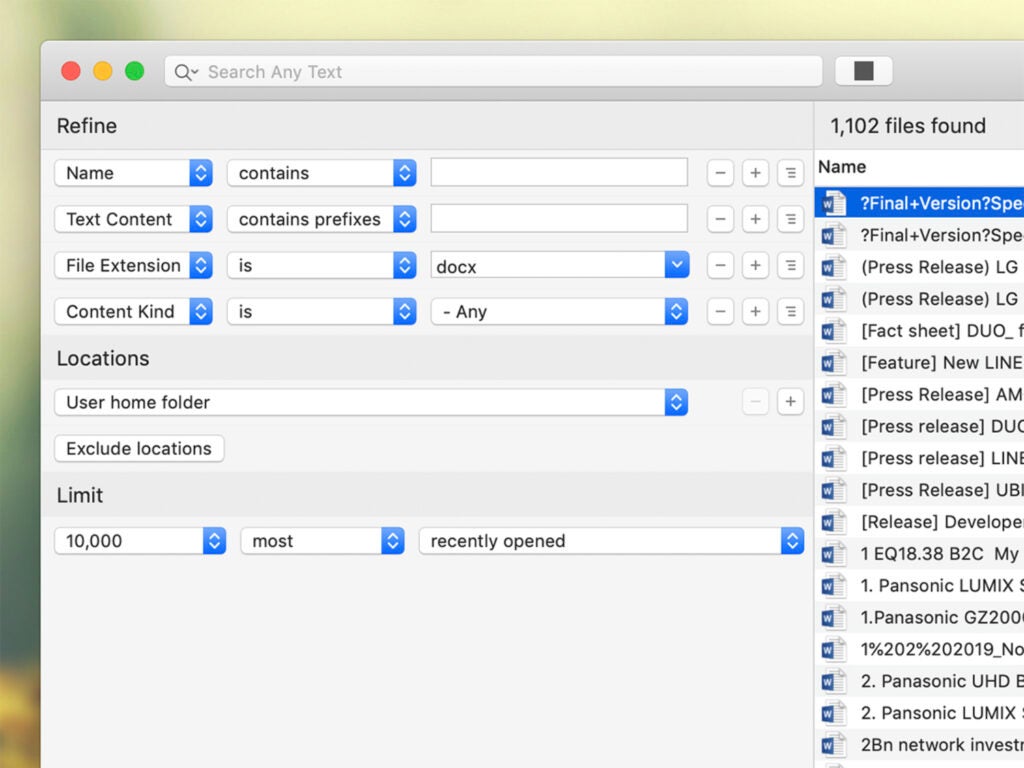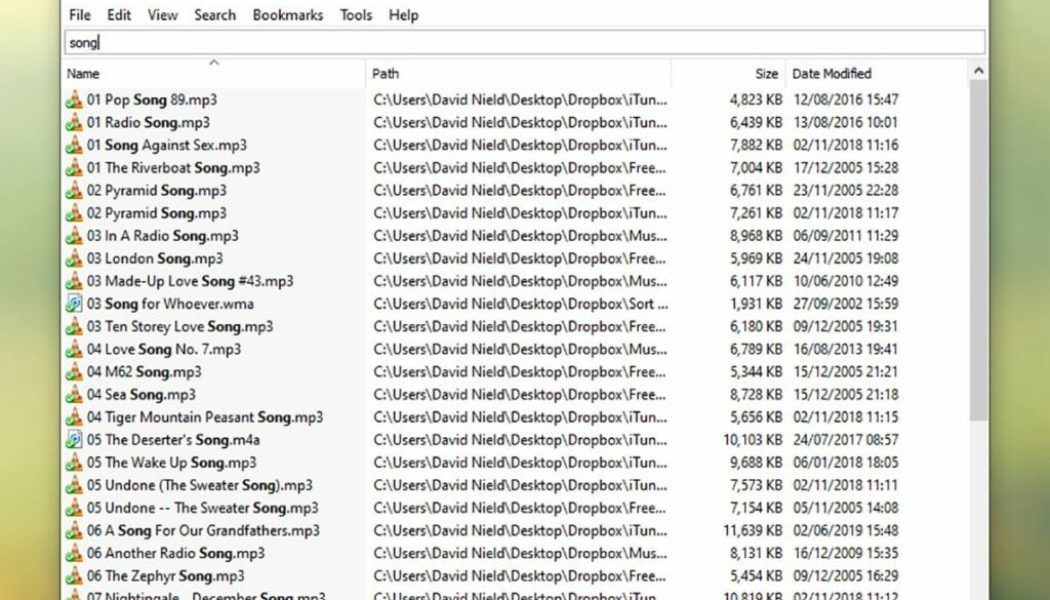You’re sure that file is here somewhere. You saw it only the other day, but it seems to have vanished. Hunting down data stashed on your computer can be a frustrating experience—partly due to our untidy habits when it comes to saving files—but it doesn’t have to be.
Both Windows and macOS come with helpful tools and tricks you can use to track down any missing file. And if that doesn’t work, there are a number of third-party applications that can help you get the job done.
How to find files on Windows 10 and 11
It may sound obvious, but the search box on the taskbar is the perfect place to start searching on Windows. If you know the name of the file you’re looking for, type it and results should appear quickly. If you don’t, enter a word that might be included in the name—even if it’s not exact, this will help you narrow your search. By default, you’ll get results within your computer, but also web and app results.
[Related: How to remove Bing results from your Windows Start menu]
You can further restrict the search to specific types of files by clicking the Documents tab at the top of the dialog box, or selecting More to gain access to the Music, Photos, and Videos tabs.
Another way to focus your search is to use a wildcard. The asterisk symbol (*) can stand for any character, a group of characters, or even entire file names. For example, you can run a search for “*.docx” to find all the Word documents stored on your system, as they share the .docx file extension. If you want to search only for images saved as JPEGs, you can type “*.jpg”. If you’re not sure of the extension for a given software or file format, you can easily find lists of the most common ones.
There’s also the question mark wildcard (?), which can stand in for any single character. Looking for “picture?.jpg” will return picture1.jpg, picture2.jpg, picture3.jpg, and so on. Wildcards can be combined or used by themselves, depending on how much you want to narrow your search.
For more precise searches, open up the folder you want to look in, and search within the box in the top right-hand corner. If you want to search the entire computer, open any folder in File Explorer, go to This PC (or the name of your PC), and find the (C:) drive. Once you’re in there, any search you run from the search box in the upper right-hand corner of the window will look at all files on that drive. As a reminder, you can do a traditional search or use any of the wildcards mentioned above.
The Search tab (Windows 10) or Search options button (Windows 11) that automatically appears at the top of the window when you run a search gives you more ways to narrow down the results list. For example, in the Refine box (Windows 10) or Size option (Windows 11), you can look for files of a particular type or size. This is especially handy if you’re looking specifically for large files on Windows.
You can also search for files that have been modified during a certain time period (like within the last day or month), which can help if you have misplaced a file you were recently working on.
[Related: 20 essential Windows keyboard shortcuts]
Another trick is to use what are known as boolean operators—primarily NOT and OR. A search for “box OR cube” will return files with either word in the filename, whereas searching for “box NOT cube” will only match files with names that include the word “box” but not “cube”.
You can also use AND to find matches for files that contain two specific terms, like “box AND cube”. These boolean operators work all around Windows and can be very helpful if you don’t remember the exact name of what you’re looking for.
If you tried the built-in tools and are still digging for the files you need, there are a couple of third-party Windows applications that might get the job done. Everything is a free app that starts by showing you every file on your system—hence the name—and then filters the list as you search.

Type your query in the search box at the top, using any relevant wildcards and boolean operators. Then use the Search menu to narrow down the results by matching entire words or by looking for specific file types. Choose Advanced Search from this menu to specify words you do or don’t want to match (you’ll also be able to search the text inside a file here). It’s not the most polished-looking app, but once you get used to it, you’ll find it a fantastic ally in your file-searching endeavors.
Another option is UltraSearch, which is also free to download. Type your search terms and narrow the matches down based on file type. You can use wildcards and search within the contents of files, but boolean operators won’t work here.
UltraSearch is more user-friendly than Everything, but it doesn’t offer as many features. What sets it apart, though, is a built-in preview tool, so you can take a quick look at the files to make sure you’ve got the right one.
How to find files on macOS

Spotlight is the hub of search on macOS, and hitting Cmd+Space on the keyboard or clicking the magnifying glass on the menu bar will launch it. Type out the name of the file you’re looking for and you can have it open in seconds.
By default, your search results will include apps, contacts, and web results, so you might need to do a bit of scrolling to get to the file you’re after. If you only want to use Spotlight to look for files, you can change your Mac’s search settings. On macOS Ventura, go to the Apple menu, click System Settings, go to Siri & Spotlight, and uncheck any categories you don’t want to appear in search results. If you’re using an older version of macOS, you can find these options by going to the Apple menu, clicking System Preferences, and going to Spotlight.
Spotlight supports plenty of natural language queries, which means you can type your search as if you were asking an actual human being. Don’t be afraid to experiment: try “photos from last month”, or “files from yesterday”. Spotlight can understand and process a wide variety of queries.
Right at the bottom of the Spotlight results list, there’s the Search in Finder link. Click it to switch your search to the Finder file manager. Alternatively, you can go directly to Finder to begin with, and then start looking via the search box in the top right-hand corner. This tool may initially appear as only a magnifying glass icon, but it will expand when you click on it.
Again, just type out the name of the file you’re looking for. Both Spotlight and Finder will search for files by their names or content, and even though boolean operators (“OR,” “NOT,” and “AND”) work, you can’t use wildcard characters like you can on Windows.
If you run a search from Finder or switch your results to Finder, you’ll see some filter suggestions appear below the search box as you type. These suggestions let you restrict the results to filename matches or specific file types.
[Related: How to rename multiple files on macOS]
Click the small plus icon below the search box to add filters. These include file types, the dates files were created or last modified, the names of the files, or their contents. You can, for example, look for filenames that start with “pic” and end with “archive” and have anything else in between.
You can also combine filters using the plus and minus icons on the right to add and remove them as required. For example, you can look for files opened within the last week that have the word “meeting” somewhere inside.
You can also use the buttons next to the word “Search” to switch between looking in the particular folder you’re viewing in Finder (and all its subfolders), or across your Mac as a whole. To change which one Finder picks by default on macOS Ventura, choose Finder > Settings > Advanced, and make your choice under When performing a search. On older versions of macOS, navigate through Finder > Preferences > Advanced to find those options.
If you’re still overwhelmed by the number of search results, use the icons on the Finder toolbar to change how they appear or are ordered on-screen.
As with Windows, several third-party options are available for even more powerful searching. HoudahSpot ($34, with a free trial available) can search several folders at once, will quickly preview files for you, and will make running complex searches easier.

Build up your search criteria using the boxes on the left—name, text content, file extension, content kind, and so on—then click the Play button up at the top to search both within the hard drive and inside each file. If you need to, you can limit the number of results returned, focusing, for example, on those most recently opened or created.
Another useful tool is Alfred, which does advanced file search and a lot more—it’s like having your own digital butler on hand. The app essentially works as a productivity enhancer for macOS, and lets you set up customized keyboard shortcuts, run automated tasks, access system commands more easily, and much more. As far as file searching goes, hit Option+Space to open the Alfred interface, then type “find”, followed by the name of the file you’re looking for.
Open Preferences from the Alfred icon on the menu bar, then go to Features and File Search—you can tell Alfred exactly where to look and how many results to show. All of this basic searching is free, but advanced filtering requires the Powerpack add-on (£34 or about $44).
You may not need these extra tools, but no matter what kind of search quest you’re going on, you should be able to find what you’re looking for—either through the native options in Windows and macOS, or an additional program. And the more you make use of these features, the more adept you’ll get at using them.
This story has been updated. It was originally published on July 22, 2019.









